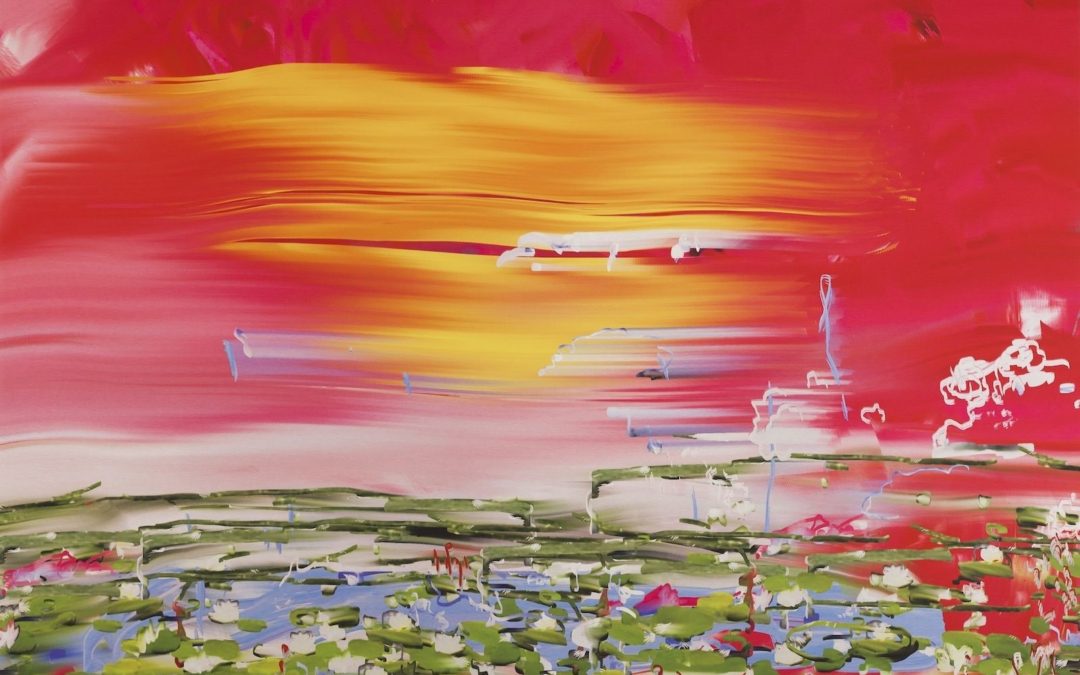The early 21st century is a time of significant change, as digital technologies begin to supersede every facet of our lives. This point in time, like any other, is manifesting through new tools of expression and production. New technologies are changing the way that we create and experience art on every level. Visionaries are using 3-D printing to redefine the art that we see and collect entirely. Artists are crafting paintings, sculptures, and entire worlds in virtual form. It is through these new tools and experiences that we take in our modern society.
Post-Internet Art is a New Movement with Work that Questions the Framework, Omnipresence, and Infinite Reproducibility of Online Culture
Artists and writers have touched upon these changes through various works and texts. One movement that was very much born out of the 21st century was Post Internet art. Post Internet as a movement seeks to create art that takes the fundamental influence the Internet has on our current age into account. The Post-Internet art object does not necessarily have any bestowed value, as images of the object that are disseminated through the Internet are equally as important. Post-Internet art can also be distinguished by the idea that the so-called “source” does not have any importance concerning a copy.
If an artist were to use a photograph, the original photograph has no inherent importance, the copies of the photograph that are being used for the given project are just as valuable. This creates a highly decentralized system in which the trillions of photos on the Internet are all equal in value. The decentralized nature of this system and its birth through the rise of the Internet has had a defining influence on Post-Internet artists working today. Post-Internet artists are certainly aware of this fact when doing their work, and their interaction with the Internet and media is a defining aspect of their product. The Ullens Center for Contemporary Art touches upon this point with its booklet for the opening of its show Art Post Internet. UCCA states,
“Just as twentieth-century modernism was in large part defined by the relationship between craft and the emergent technologies of manufacturing, mass media, and lens-based imagery, the most pressing condition underlying contemporary culture today—from artistic practice and social theory to our quotidian language—may well be the omnipresence of the Internet.”
Karen Archey & Robin Peckham, Art Post-Internet
New Industries are being Created in the Art World as Technology Allows Companies to Push the Boundaries of Buying and Selling Art
Post internet’s idea of a single object holding no precedence over a copy has found footing in the art world. General Public, a project by actress Portia de Rossi is pushing the boundaries of the original being out of reach to more than one person. Using 3-D printing technology De Rossi is creating exact replicas of physical paintings. These replicas can be purchased for an average of one thousand dollars and are allowing people who do not have the time or interest to research artists through galleries to begin an art collection. This leads to a democratization of art as copies of the artist’s paintings will reach the walls of many more people and a more diverse economic background than the ultra-wealthy and famous.
Many facets of De Rossi’s project rely upon the contemporary explosion of technological advancement that can be seen in the world today. The most obvious of these is the new potential of 3-D printing technology and the extent to which we can make exact replicas of objects. In a similar vein to how Post-Internet artists admit to technological advancement -the Internet- changing the nature of their practice, so too does Portia de Rossi comment on the fact that she is addressing the new ways in which technology is fundamentally changing the art world. De Rossi states that as an artist herself, she has seen every artistic industry change through technology. As she says in Architectural Digest,
“For example, the printing press and the Internet have revolutionized writing; the phonograph and the MP3 have revolutionized music. Also, yet gallerists still control painters’ careers.”
Portia de Rossi, Architectural Digest
Her point is that these new technologies allow artists to take out the middleman in the market and so benefit the artists to a higher degree than if they went through a gallerist or music label. De Rossi’s “Synograph’s” (a synergy of art and technology) are the tools that the artist can use to supersede the middleman. Developed between her efforts and Fujifilm, De Rossi has high hopes that her 3-D printed paintings will upheaval the entire art world.
Old Mediums such as Painting and Sculpture are being Reimagined in a Virtual Perspective
The lack of emphasis on a single, unique object and the use of digital technology with painting has some history in the Post-Internet artists of the late 2000s and present day. Many digital painters have been doing work that goes so far as even to question the basis of creating a physical object in the context of painting. Their work also naturally speaks to the idea that digital paintings can be reproduced infinitely- and so in many ways comes from the same stem as De Rossi’s General Public. Digital painting, in many ways, can be seen to be harmonious with the ideas of early Post-Internet artists and thinkers.
Petra Cortright is at the Center of the Art World Fascination with Digital Painting, i.e., the Creation of a Painting Using Software
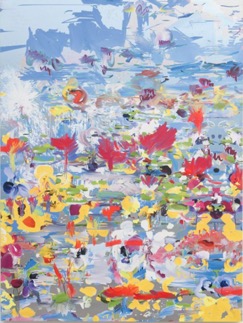 Petra Cortright is an artist who was born in Santa Barbara, California in 1986. She is considered one of the most notable Post-Internet artists of today. She is based in California and is most noted for her works in painting, video, and digital media. Petra Cortright is probably one of the more internationally renowned digital painters currently, and her works speak to traditional painting practices while using new media.
Petra Cortright is an artist who was born in Santa Barbara, California in 1986. She is considered one of the most notable Post-Internet artists of today. She is based in California and is most noted for her works in painting, video, and digital media. Petra Cortright is probably one of the more internationally renowned digital painters currently, and her works speak to traditional painting practices while using new media.
Cortright’s works can be seen as an exploration of the abstract principles of painting through a digital tool, namely Adobe Photoshop. Cortright has stated that her work is created through an intense layering process. Her Photoshop files which contain hundreds of layers are eventually found to be at a “stopping point” at which point the image is printed, creating a painting. In some way Petra’s strokes are Abstract-Expressionist and Impressionist in nature, violently crisscrossing and dotting color on the canvas.
Cortright stands at an interesting intersection between painting and digital art. Many of the facets of Cortright’s painting speak to the transmission of traditionalist painting techniques into digital technology. This can be seen in Cortright’s work “MSExcel Password msexchange msgre32.dll msgsrv32 devcon32 mshearts.exe msi reports ms.jennifer brooks”, (2014) in which she creates an almost impressionistic effect using the digital paintbrush. One can see the layering process of the piece using the “paint.” Many of the brushstrokes are placed on top of one another, creating depth. This can be a challenging effect to achieve, as the natural orientation of a digital painting tends to be flattened. Cortright creates a background consisting of both light and dark hues of blue, which creates the effect of an atmosphere. On top of this, she seems to put dabs of paint, utilizing a texture. The dabs of paint on the canvas are very expressionistic, and one is reminded of Abstract-Expressionism in their almost violent application.
Cortright can also be seen to be playing with ideas of repetition, as her red strokes across the center of the canvas show. This is balanced out by the sporadic nature of the yellow dabs of paint near the bottom of the image. Overall the painting seems to lie on two planes, one blue background and a foreground of red and yellow dabs of paint. The beauty of the complex nature of the colors and their interaction with each other provide an interesting contrast to the duller yet active background. Upon closer inspection of some of the red and yellow dabs of paint, one can see the most graphic nature of the image. The yellow shapes are noted to have hard edges, which can be understood because of her use of graphic design software. It is important to note that Cortright is not trying to define a new way of painting. Instead, she is experimenting with existing painting processes while simply updating her medium. The Los Angeles Times comments upon this use of historicity in Courtright’s paintings through her connection to Abstract Expressionists,
“The intuition comes in the compositions. Cortright piles on loops, swoops, scribbles, and slathers, invoking the ironic fusion of personal gesture and impersonal mass-production in Roy Lichtenstein’s sleek brushstroke paintings from 1965-66. Where he made big gestures, however, which befit the crushing scale of the banality that had come to engulf Abstract Expressionist art, she taps into the sheer volume of today’s roaring digital deluge.”
Christopher Knight, Los Angeles Times
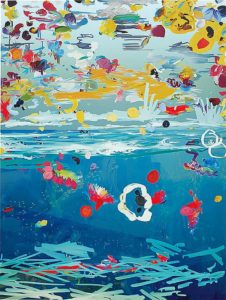
This use of an updated medium can be seen clearly in Cortright’s process as her final paintings become a GIF, videos, or prints. Whatever the final format, Cortright’s work can be seen as a conversation with the digital object that is created through Photoshop.
Cortright’s studio practice considers the Internet, as she is often surfing the web before painting. This interaction with the web and her use of images from the web in her paintings can be seen as the connection between her and Post-Internet art, as Gene McHugh stated that Post-Internet is art made after one’s use of the Internet.
Cortright again experiments with the notion of painting and digital imagery within a contemporary context with her painting all_gold_everything.psd. There are two versions of this painting, a video, and a GIF. Through the GIF, one can see the layering process of the painting. Like a physical painting, the image takes on a new life with each brushstroke. It is much simpler to fill a digital painting as one has to move their hand over the stylus with a broad “brush” to create a new layer. Depending on the size of the painting, this could be an arduous process in real life. Thus, the hundreds of layers that are created in the digital image require much less labor. Cortright’s dramatic changes seen through each layer are commented on by critics, “The gif begins with an image of a golden dress worn by a catwalk model, a jpeg copied from the web. From there, the relationship between one frame and the next is unpredictable; in some cases, there is a small change, but often the changes are abrupt, with large images or fields of color covering the entire canvas, concealing what came before. There are effects, transformations, copied elements, and brushstrokes, which are sometimes delicately rendered and sometimes scribbled roughly.”
Cortright’s connection with the Internet is integral to her work, as it begins literally with an image from the web. The interaction between traditional painting practices: brushstrokes, two-dimensional composition, and repetition allows the artwork to occupy the space between totally digital work and work that relates to the physical world.
Andrej Ujházy uses Traditional Painting Techniques with a Stylus and Computer to make Virtual Landscape and History Paintings
Andrej Ujházy is an artist who has been gaining popularity in recent years for his digital paintings. His paintings can be seen on his blog, which ranges from landscapes to moving paintings. Ujházy is well known for his use of video games as a source of inspiration. Many of his works have a science fiction type of appeal, making use of zombies, knights, and battles. Other works lend themselves to peaceful landscapes in which he displays his expert use of a tablet and photoshop or MS Paint.
When one compares the similarities to concept art, one can understand his work at a new level. Concept art is art that is made for video games, movies, and graphic novels. Almost all artists who work in the realm of concept art make use of a tablet and computer to do their work. Concept art is a form of illustration and enjoys immense popularity in online communities. One only must look at the front page of Reddit- a popular chat forum, under the “Art” section to see many examples of concept art being used.
While in the past, many artists who worked in the realm of concept art would make use of traditional mediums, the present day has seen almost all artists go digital and use a tablet. Ujházy can be seen to be commenting on this approach of working with his use of a tablet. Despite using an “updated medium,” Ujházy’s paintings have many classical references. It is evident in most of the paintings that skill is necessary to render the figures, buildings, and landscapes. A good example of Ujházy’s landscape work can be found in his blog post under “December 2016” at 12/25/2016 05:37:00 PM. This landscape work features a simple mountain. A flat blue-sky contrast against a white mountain is slightly blurred due to the atmospheric perspective. Ujházy uses a subtle range of tones and colors, ranging from cool reds to light blues- which blend in nicely with the white. To add contrast to the image, there is a shadowy black valley penetrating the middle of the mountains. Ujházy shows his mastery of implied and direct line-making, as can be seen through the top of the mountain on the right, and the side of the center mountain. The top of the painting is colored blue, and the bottom is white, which creates a nice balance.
Ujházy maintains close ties with landscape and figure painting, and the classics are well represented in his works. This creates an interesting tension in the sense that he is using a relatively new medium but making use of ancient subjects. One of Ujházy’s more popular works featured on Rhizome’s exhibit “brushes” is his congress of the Sarmatian women by the black sea to dissolve the Amazonian tribes and withdraw from history, aug1 333 (after Total War: Atilla™).png (2015). This painting, when downloaded, is quite large and requires the viewer to scroll through it. This makes the experience of the painting quite different from what one would see in a gallery or museum. The task of scrolling through the work allows one to appreciate the inner workings of the painting and the fine details of the brushstrokes. The impossibility of viewing the entire image can even be frustrating but can be alleviated by downloading the entire painting and opening it in a photo viewer.
Ujházy created this work while playing the video game Rome: Total War, which features armies fighting in vast landscapes in the late Roman Era. Ujházy hoped to comment on the narrative of the game and the video game industry altogether by playing as a tribe with whom women played an essential role in warfare. This tribe, the Sarmatians-were said to be descendants of the Amazonian tribe.
A significant aspect of Ujházy’s practice is his immersion in online communities that practice the digital arts. These online communities are most often made up on forums, or websites such as DeviantArt. Artists gather on these platforms to showcase their digital paintings, usually created in Adobe Photoshop or MS Paint. Of importance is the strong emphasis in these communities on academic drawing and painting, which Ujházy is utilizing with his accurately rendered sky. The artist also makes an apparent reference to history painting, as the scene depicts a grand narrative of two tribes coming together to make peace.
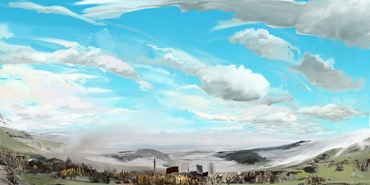
The Old and the New Collide in the New Art Movements of the 21st Century
The Internet and the ubiquity of digital technology have drastically changed how people create, view, and discuss art in the world today. New practices such as digital painting show how thousand-year-old traditions of craftsmanship can be revitalized into new works using technology, aesthetics, and stories from our current day and age. This juxtaposition between the old and new, between tradition and the future is what makes the current period that we live in such an exciting time for contemporary art and modern culture at large.
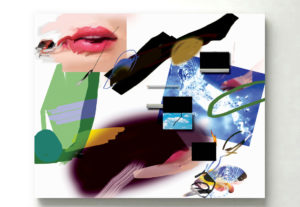
Digital Painting by Alexandra Gorczynski

